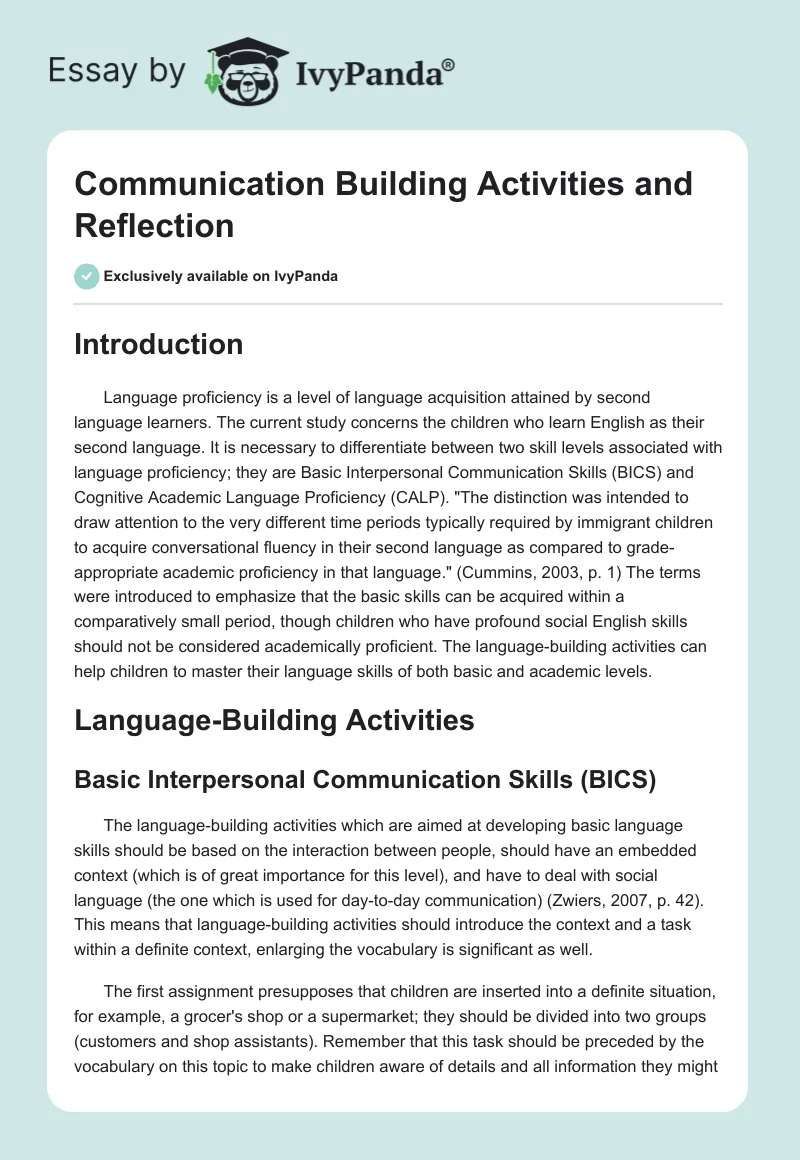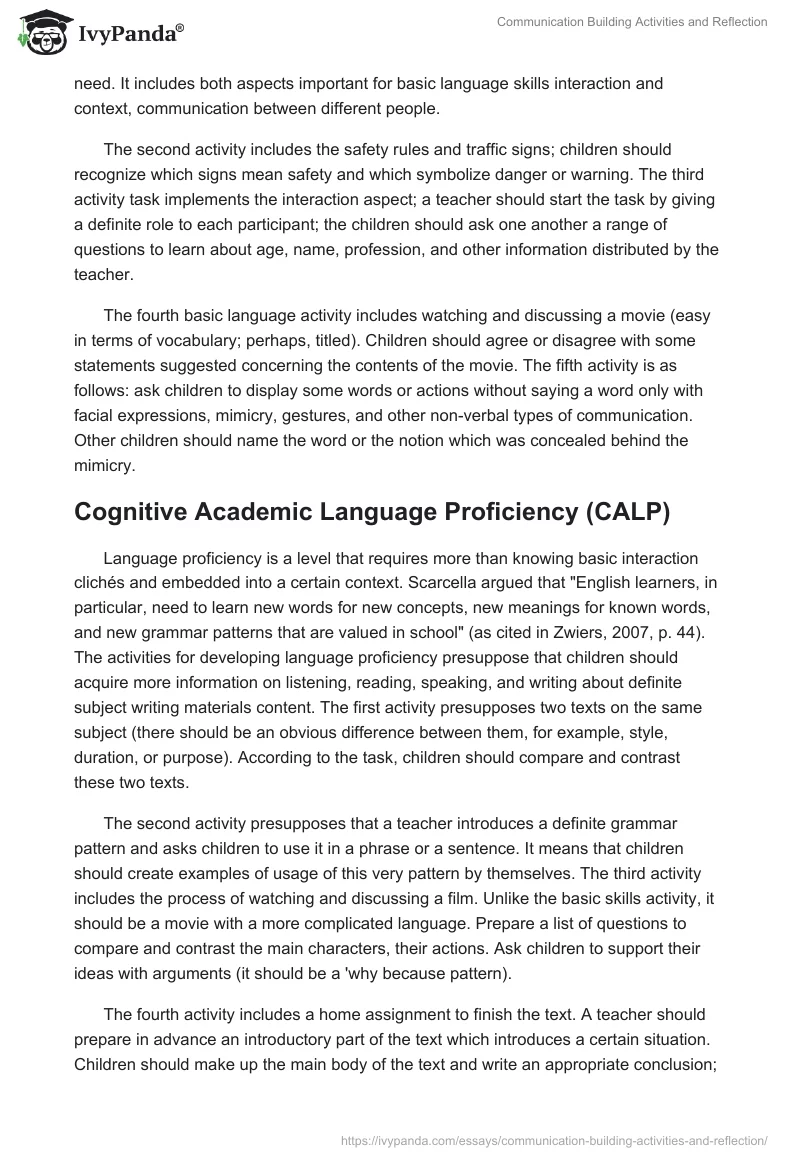Introduction
Language proficiency is a level of language acquisition attained by second language learners. The current study concerns the children who learn English as their second language. It is necessary to differentiate between two skill levels associated with language proficiency; they are Basic Interpersonal Communication Skills (BICS) and Cognitive Academic Language Proficiency (CALP). “The distinction was intended to draw attention to the very different time periods typically required by immigrant children to acquire conversational fluency in their second language as compared to grade-appropriate academic proficiency in that language.” (Cummins, 2003, p. 1) The terms were introduced to emphasize that the basic skills can be acquired within a comparatively small period, though children who have profound social English skills should not be considered academically proficient. The language-building activities can help children to master their language skills of both basic and academic levels.
Language-Building Activities
Basic Interpersonal Communication Skills (BICS)
The language-building activities which are aimed at developing basic language skills should be based on the interaction between people, should have an embedded context (which is of great importance for this level), and have to deal with social language (the one which is used for day-to-day communication) (Zwiers, 2007, p. 42). This means that language-building activities should introduce the context and a task within a definite context, enlarging the vocabulary is significant as well.
The first assignment presupposes that children are inserted into a definite situation, for example, a grocer’s shop or a supermarket; they should be divided into two groups (customers and shop assistants). Remember that this task should be preceded by the vocabulary on this topic to make children aware of details and all information they might need. It includes both aspects important for basic language skills interaction and context, communication between different people.
The second activity includes the safety rules and traffic signs; children should recognize which signs mean safety and which symbolize danger or warning. The third activity task implements the interaction aspect; a teacher should start the task by giving a definite role to each participant; the children should ask one another a range of questions to learn about age, name, profession, and other information distributed by the teacher.
The fourth basic language activity includes watching and discussing a movie (easy in terms of vocabulary; perhaps, titled). Children should agree or disagree with some statements suggested concerning the contents of the movie. The fifth activity is as follows: ask children to display some words or actions without saying a word only with facial expressions, mimicry, gestures, and other non-verbal types of communication. Other children should name the word or the notion which was concealed behind the mimicry.
Cognitive Academic Language Proficiency (CALP)
Language proficiency is a level that requires more than knowing basic interaction clichés and embedded into a certain context. Scarcella argued that “English learners, in particular, need to learn new words for new concepts, new meanings for known words, and new grammar patterns that are valued in school” (as cited in Zwiers, 2007, p. 44). The activities for developing language proficiency presuppose that children should acquire more information on listening, reading, speaking, and writing about definite subject writing materials content. The first activity presupposes two texts on the same subject (there should be an obvious difference between them, for example, style, duration, or purpose). According to the task, children should compare and contrast these two texts.
The second activity presupposes that a teacher introduces a definite grammar pattern and asks children to use it in a phrase or a sentence. It means that children should create examples of usage of this very pattern by themselves. The third activity includes the process of watching and discussing a film. Unlike the basic skills activity, it should be a movie with a more complicated language. Prepare a list of questions to compare and contrast the main characters, their actions. Ask children to support their ideas with arguments (it should be a ‘why because pattern).
The fourth activity includes a home assignment to finish the text. A teacher should prepare in advance an introductory part of the text which introduces a certain situation. Children should make up the main body of the text and write an appropriate conclusion; this task develops analytical thinking. The fifth activity presupposes the recitation of simple poems (Marsland, 1998, p. 65). It means that short and comparatively simple poems should be distributed between groups of children and in some time (state a time limitation) these poems should be recited.
Reflection of the experience
Two activities were introduced in the class. The first activity was the basic skills activity aimed at developing the communication skills of children for who English is their second language. It implemented the interaction aspect; I started the task by giving a definite role to each participant; the children were supposed to ask one another a range of questions to learn about age, name, profession, and other information distributed by the teacher. This task was a great success; children were not always correct while presenting their questions, though they were interested in roles assigned to their fellow mates. I believe that this practice should be introduced as a warming up activity or activity that separates two independent parts of a lesson.
The second activity concerned the language proficiency of children. This task included a home assignment which was to finish the text. I have prepared in advance an introductory part of the text which introduced a certain situation (it was a lonely hunter who has met a wild tiger in the jungle). Children were supposed to make up the main body of the text and write an appropriate conclusion. It took a bit more time than I thought it would. Children asked their parents to do the assignment for them; I guess it can be considered too complicated for children of this level. However, some children have coped with the task without any help. They have shown good analytical and writing skills in combination with proficient vocabulary.
Conclusion
The language-building activities are aimed at making the process of learning the second language more interesting and effective. Though not all types of activities can be considered appropriate for all learning levels, children find these activities rather interesting and challenging. The basic language skills can be developed with the help of different games that demand a definite context and communication (mainly oral). Language proficiency requires learning new meanings of known words, new concepts, and new grammatical structures. Different patterns can be introduced to facilitate the learning process.
Reference
Cummins, J. (2003). BICS and CALP. Web.
Marsland, B. (1998). Lessons from Nothing: Activities for Language Teaching With Limited Time and Resources. USA: Cambridge University Press
Zwiers, J. (2007). Building Academic Language: Essential Practices for Content Classrooms, Grades 5-12. San Francisco: John Wiley and Sons


